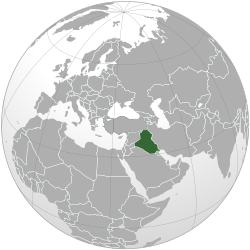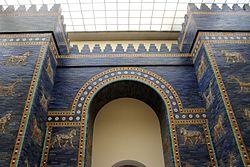Kingdom of Iraq
This article may require cleanup to meet Wikipedia's quality standards. The specific problem is: Map in infobox is not accurate to the time period. (December 2017) |
The Hashemite Kingdom of Iraq المملكة العراقية الهاشمية al-Mamlakah al-‘Irāqiyyah Al-Hāshimīyah شانشينى عێراق ھاشیمی Shanshani Iraq Hāshimīy | |||||||||
|---|---|---|---|---|---|---|---|---|---|
| 1932–1958 | |||||||||
| Anthem: None Royal anthem السلام الملكي As-Salam al-Malaki "The Royal Salute" | |||||||||
 | |||||||||
| Capital | Baghdad | ||||||||
| Common languages | Arabic Assyrian Kurdish Persian English | ||||||||
| Religion | Islam · Christianity Judaism · Yazidism Mandaeism | ||||||||
| Government | Constitutional monarchy | ||||||||
| King | |||||||||
• 1932–1933 | Faisal I | ||||||||
• 1933–1939 | Ghazi | ||||||||
• 1939–1958 | Faisal II | ||||||||
| Prime Minister | |||||||||
• 1920-1922 | Abd Al-Rahman Al-Gillani (first) | ||||||||
• 1958 | Ahmad Mukhtar Baban (last) | ||||||||
| Historical era | Interwar period, World War II, Cold War | ||||||||
• Independence from United Kingdom | 3 October 1932 | ||||||||
| 1 April 1941 | |||||||||
• Admitted to the United Nations | 24 October 1945 | ||||||||
| 24 February 1955 | |||||||||
| 14 July 1958 | |||||||||
| Area | |||||||||
| 1958 | 438,317 km2 (169,235 sq mi) | ||||||||
| Population | |||||||||
• 1958 | 6,488,000 | ||||||||
| ISO 3166 code | IQ | ||||||||
| |||||||||
| Today part of | |||||||||
| History of Iraq |
|---|
 |
|
|
The Hashemite Kingdom of Iraq (Arabic: المملكة العراقية الهاشمية al-Mamlakah al-‘Irāqiyyah Al-Hāshimīyah) was founded on 23 August 1921 under British administration following the defeat of the Ottoman Empire in the Mesopotamian campaign of World War I. Although a League of Nations mandate was awarded to the UK in 1920, the 1920 Iraqi revolt resulted in the scrapping of the original mandate plan in favor of a British administered semi-independent kingdom, under the Hashemite allies of Britain, via the Anglo-Iraqi Treaty. The kingdom of Iraq was granted full independence in 1932,[1] following the Anglo-Iraqi Treaty (1930). The independent Iraqi Kingdom under the Hashemite rulers underwent a period of turbulence through its entire existence. Establishment of Sunni religious domination in Iraq was followed by Assyrian, Yazidi and Shi'a unrests, which were all brutally suppressed.[citation needed] In 1936, the first military coup took place in the Kingdom of Iraq, as Bakr Sidqi succeeded in replacing the acting Prime Minister with his associate. Multiple coups followed in a period of political instability, peaking in 1941.
During World War II, the Iraqi regime of Regent 'Abd al-Ilah was overthrown in 1941 by the Golden Square officers, headed by Rashid Ali. The short-lived pro-Nazi government of Iraq was defeated in May 1941 by the allied forces in the Anglo-Iraqi War. Iraq was later used as a base for allied attacks on the Vichy-French-held Mandate of Syria and support for the Anglo-Soviet invasion of Iran. At the same time, the Kurdish leader Mustafa Barzani led a rebellion against the central government in Baghdad. After the failure of the uprising Barzani and his followers fled to the Soviet Union.
In 1945, during the final stages of World War II, Iraq joined the United Nations and became a founding member of the Arab League. In 1948, massive violent protests, known as the Al-Wathbah uprising broke out across Baghdad as a popular demand against the government treaty with the British, and with communist party support. More protests continued in spring, but were interrupted in May, with the martial law, when Iraq entered the 1948 Arab-Israeli War along with other members of the Arab League.
In February 1958, King Hussein of Jordan and `Abd al-Ilāh proposed a union of Hāshimite monarchies to counter the recently formed Egyptian-Syrian union.[citation needed] The resulting Arab Federation, formed on 14 February 1958 was short-lived. It ended in 1958, when the monarchy was overthrown in a military coup, led by Abd al-Karim Qasim.
Prior to independence - British administration
The territory of Iraq was under Ottoman dominance until the end of World War I, becoming an occupied territory under British military from 1918. In order to transform the region to civil rule, Mandatory Mesopotamia was proposed as a League of Nations Class A mandate under Article 22 and entrusted to Britain, when the former territories Ottoman Empire were divided in August 1920 by the Treaty of Sèvres. However, the 1920 Iraqi revolt resulted in the scrapping of the original mandate plan in favor of British administered semi-independent kingdom, under the Hashemite allies of Britain, via the Anglo-Iraqi Treaty.
Faisal ibn Husayn, who had previously been proclaimed King of Syria by a Syrian National Congress in Damascus in March 1920, was ejected by the French in July of the same year. Faisal was then granted the territory of Iraq, to rule it as a protected kingdom, with the British RAF retaining certain military control, though de facto, the territory remained under British administration until 1932.
The civil government of postwar Iraq was headed originally by the High Commissioner, Sir Percy Cox, and his deputy, Colonel Arnold Wilson. British reprisals after the murder of a British officer in Najaf failed to restore order. British administration had yet to be established in the mountains of north Iraq. The most striking problem facing the British was the growing anger of the nationalists.
History
Independence
With the signing of the Anglo-Iraqi Treaty and the settling of the Mosul Question, Iraqi politics took on a new dynamic. The emerging class of Sunni and Shia landowning tribal sheikhs vied for positions of power with wealthy and prestigious urban-based Sunni families and with Ottoman-trained army officers and bureaucrats. Because Iraq's newly established political institutions were the creation of a foreign power, and because the concept of democratic government had no precedent in Iraqi history, the politicians in Baghdad lacked legitimacy and never developed deeply rooted constituencies. Thus, despite a constitution and an elected assembly, Iraqi politics was more a shifting alliance of important personalities and cliques than a democracy in the Western sense. The absence of broadly based political institutions inhibited the early nationalist movement's ability to make deep inroads into Iraq's diverse social structure.
The new Anglo-Iraqi Treaty was signed in June 1930. It provided for a "close alliance," for "full and frank consultations between the two countries in all matters of foreign policy," and for mutual assistance in case of war. Iraq granted the British the use of air bases near Basra and at Al Habbaniyah and the right to move troops across the country. The treaty, of twenty-five years' duration, was to come into force upon Iraq's admission to the League of Nations. This occurred on October 3, 1932.
In 1932, the Kingdom of Iraq was granted independence under King Faisal I. However the British retained military bases in the country. Iraq was granted official independence on October 3, 1932 in accordance with an agreement signed by the United Kingdom in 1930, whereby the United Kingdom would end its effective mandate on the condition that the Iraqi government would allow British advisers to take part in government affairs, allow British military bases to remain, and a requirement that Iraq assist the United Kingdom in wartime.[2] Strong political tensions existed between Iraq and the United Kingdom even upon gaining independence. After gaining independence in 1932 the Iraqi government immediately declared that Kuwait was rightfully a territory of Iraq. Kuwait had loosely been under the authority of the Ottoman vilâyet of Basra for centuries until the British had formally severed it from the Ottoman influence after World War I and on this basis the Iraqi government stated that Kuwait was a British imperialist invention.[3]
Political instability and army coups, 1933–1941
After Faisal died in 1933, King Ghazi reigned as a figurehead from 1933 to 1939, when he was killed in a motor accident. Pressure from Arab nationalists and Iraqi nationalists demanded that the British leave Iraq, but their demands were ignored by the United Kingdom.
Upon achieving independence in 1932, political tensions arose over the continued British presence in Iraq, with Iraq's government and politicians split between those considered pro-British politicians such as Nuri as-Said, who did not oppose a continued British presence and anti-British politicians, such as Rashid Ali al-Gaylani, who demanded that remaining British influence in the country be removed.[4]
Various ethnic and religious factions tried to gain political accomplishments during this period, often resulting in violent revolts and a brutal suppression by the Iraqi military, led by Bakr Sidqi. In 1933, thousands of Assyrians were killed in Simele massacre, in 1935–1936 a series of Shi'a uprisings were brutally suppressed in mid-Euphrates region of Iraq,[5] and in parallel an anti-conscription Kurdish uprising in the north and a Yazidi revolt in Jabal Sinjar were crushed in 1935. Throughout the period political instability led to an exchange of numerous governments. Bakr Sidqi himself ascended to power in 1936, following a successful coup d'état.
From 1917 to 1946, five coups by the Iraqi Army occurred, led by the chief officers of the army against the government to pressure the government to concede to army demands.[4]
Anglo-Iraqi War and second British occupation
The 1941 Iraqi coup d'état overthrew Nuri as-Said and placed Rashid Ali al-Gaylani as prime minister of a pro-Nazi government. Ali did not overthrow the monarchy, but installed a more compliant Regent, and attempted to restrict the rights of the British under the treaty from 1930. Rashid Ali's attempted to secure control over Iraq asking assistance of Nazi Germany, Fascist Italy and Imperial Japan.
On April 20 the Iraqi Army established itself on the high ground to the south of the Habbaniya air force base. An Iraqi envoy was sent to demand that no movements, either ground or air, were to take place from the base. The British refused the demand and then themselves demanded that the Iraqi army leave the area at once. After a further ultimatum given in the early hours of May 2 expired, at 0500 hours the British began bombing the Iraqi troops threatening the base, marking the beginning of the Anglo-Iraqi War.
Hostilities lasted from May 2 to May 31, 1941 between Iraqis and the British and their indigenous Assyrian Levies. The British would continue to occupy Iraq for many years afterwards.
In the aftermath of the Iraqi defeat, a bloody Farhud massacre broke out in Baghdad on June 2, initiated by the Futuwwa youth and Rashid Ali's supporters, resulting in deaths of some 180 Jews and heavy damage to the Jewish community.
1941–1958
After the Anglo-Iraqi War ended, Nuri as-Said returned as Prime Minister and dominated the politics of Iraq until the overthrow of the monarchy and his assassination in 1958. Nuri as-Said pursued a largely pro-western policy during this period.[6]
Republic declared
The Hashemite monarchy lasted until 1958, when it was overthrown through a coup d'état by the Iraqi Army, known as the 14 July Revolution. King Faisal II along with members of the royal family were executed. The coup brought Abd al-Karim Qasim to power. He withdrew from the Baghdad Pact and established friendly relations with the Soviet Union.
See also
- List of Kings of Iraq
- Republic of Iraq
- History of Iraq
- San Remo Conference, the conference among victorious Allied powers that partitioned the Ottoman Empire led to the Kingdom of Iraq
References
- ^ Hunt, C. 2005
- ^ Ghareeb, Edmund A.; Dougherty, Beth K. Historical Dictionary of Iraq. Lanham, Maryland and Oxford: The Scarecrow Press, Ltd., 2004. p. lvii.
- ^ Duiker, William J.; Spielvogel, Jackson J. World History: From 1500. 5th edition. Belmont, California, USA: Thomson Wadsworth, 2007. p. 839.
- ^ a b Ghareeb; Dougherty. p. lvii
- ^ Gareth Stansfield; Anderson, Liam D. (2004). The Future of Iraq: Dictatorship, Democracy or Division?. Basingstoke: Palgrave Macmillan. ISBN 1-4039-6354-1.
- ^ Ghareeb; Dougherty. p. lviii


